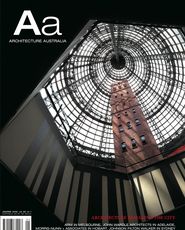HOW TO PLAN A WORKING HARBOUR?
Sydney’s East Darling Harbour competition has generated ongoing controversy. Alexandra Matyear considers the diverse opinions voiced in a debate about planning processes, the competition and possible futures for a working harbour.
Sydney’s East Darling Harbour (EDH) competition has been a source of ongoing controversy, but there has been little critical debate in the public domain about recent changes made by the NSW State Government to the Working Harbour Policy 2003. (All references to this previous legislation had been withdrawn from the internet when the EDH competition was announced by the Carr Government in May 2005.) Concerned about the apparent lack of information, strategic planning and public debate, DARCH, the young architects’ committee of the RAIA NSW Chapter, organized a forum to examine the planning processes that led to the competition brief and its place in the ongoing debate about whether Port Jackson should remain a working harbour. Six speakers with backgrounds in planning, architecture, property investment, strategic economics and business development engaged in a spirited discussion led by Malcolm Craig, QC in environment and planning law.
As expected, more questions arose from the forum than were resolved. The multi-faceted discussion reflected the complexity of issues at stake and highlighted the need for a slow, carefully considered, well-debated move into future decisions about the last of the harbour-front ex-stevedoring sites. Speakers’ perceptions of a “working harbour of the future” varied, but there was a common objection to the prospect of Port Jackson becoming an “elite Monte-Carlo-style pleasure ground”. Most also agreed that a nostalgic attachment to the maritime past was not, alone, sufficient reason to be concerned about the recent changes to state government policy on a working harbour.
Jacqui Goddard, Conservation Director at the National Trust, referred to a public document published by the NSW State Government in 2000 titled Sharing Sydney.
It describes a working harbour as including “Sydney Port Corporation activities at Glebe Island and White Bay, maritime refuelling facilities, maritime repair, recreational and commercial boating facilities, maritime support services and Naval defence facilities”. However, although the government continues to pay lip service to an ongoing working harbour, this document and any detailed definition of it has been quietly withdrawn with the shortening of the stevedoring lease at White Bay and the announcement of a $500 million port expansion at Botany Bay. Clearly, there is vested political interest in remaining vague.
Rod Simpson, architect and planner, expressed concern about the development of each harbour-front site in isolation from the next. A “big picture” strategic land-use plan recognizing these sites in the broader economic and cultural context of the whole harbour and Sydney’s future growth would allow details of individual site development to fall into place. The long-awaited Metropolitan Planning Strategy will be a big step in the right direction, and will be a significant test of the Premier’s ability to encourage a strategic approach to Sydney’s planning, but it will also come too late. The chance of Port Jackson remaining a viable port has been virtually eliminated with the piece-by-piece sale of publicly owned brownfield sites, resulting in vast, heavy-handed, strata-titled, singularly authored precincts like Balmain Shores and Birkenhead Point, never again being available for large-scale public use.
Port Jackson is recognized as the finest deep-water harbour in the world. However, to maintain its status as a growing “global city”, Sydney must now resort to the ongoing dredging of a second-rate harbour down the road, devastating fish breeding grounds in the Penrhyn Estuary and dumping tonnes of concrete and landfill, to create 70 hectares of new port infrastructure – despite the fact that this is the same size as the existing rail-serviced port facility soon to cease operation at White Bay.
Ken Morrison, executive director of the Property Council of Australia, pointed out that Sydney’s CBD needs more first-class office space if it is to attract globally significant businesses and that EDH represents the last opportunity to expand the CBD. Graham Larcombe, director of Strategic Economics at the Department of Planning, agreed and described an ideal model for Sydney’s economic growth as a compact city, with concentrated infrastructure investment. So, it is easy to see why EDH is being developed. A vast slab of open space represents a logistically simple and lucrative development opportunity compared to the alternative of urban renewal. Interestingly, Parramatta and North Sydney’s CBD are suffering a mass exodus of significant businesses unsatisfied with its ageing building stock: Optus’s departure is North Sydney’s latest casualty.
At what point will urban renewal of such precincts become a serious option for meeting the demands of Sydney’s growth?
As Peter Seamer, CEO of City of Sydney Council, identified, probably not until strata titling is eliminated, and the supply of brownfield sites has dried up.
Any intelligent argument supporting ongoing stevedoring activity at EDH is thwarted by the site’s physical isolation – a fact acknowledged by the panel. However, there was discord between speakers regarding prospective development. Bill Dunbar, Business Development Director, Government CPG, questioned the compulsive need for every corner of the city to be self-consciously “designed”, and called for the site to be left fallow until the use of this large slab of strategic land could be carefully considered in the best interest of the city’s future.
Given the real estate value of EDH, it is hardly surprising that the NSW State Government is in a rush to develop. The EDH “ideas” competition was announced in May 2005, and, given the lack of integrated planning resources available at the time and the site-specific nature of the brief, it seems unlikely that the brief was considered in the broader long-term strategic context of Sydney’s future growth.
Despite the shortcomings of the competition, it must be acknowledged that it has indeed resulted in some excellent debate. Certainly a half-baked competition is better than none at all. As the possibility of prospective redevelopment of White Bay and the Fish Markets sites approaches we must acknowledge our responsibility to the public and the future of Sydney and, as a profession, demand a very carefully considered approach to land-use decisions regarding these last, large-scale brownfield sites in inner Sydney. ALEXANDRA MATYEAR IS A PARTNER IN WHITCHER MATYEAR ARCHITECTS AND A MEMBER OF DARCH.















